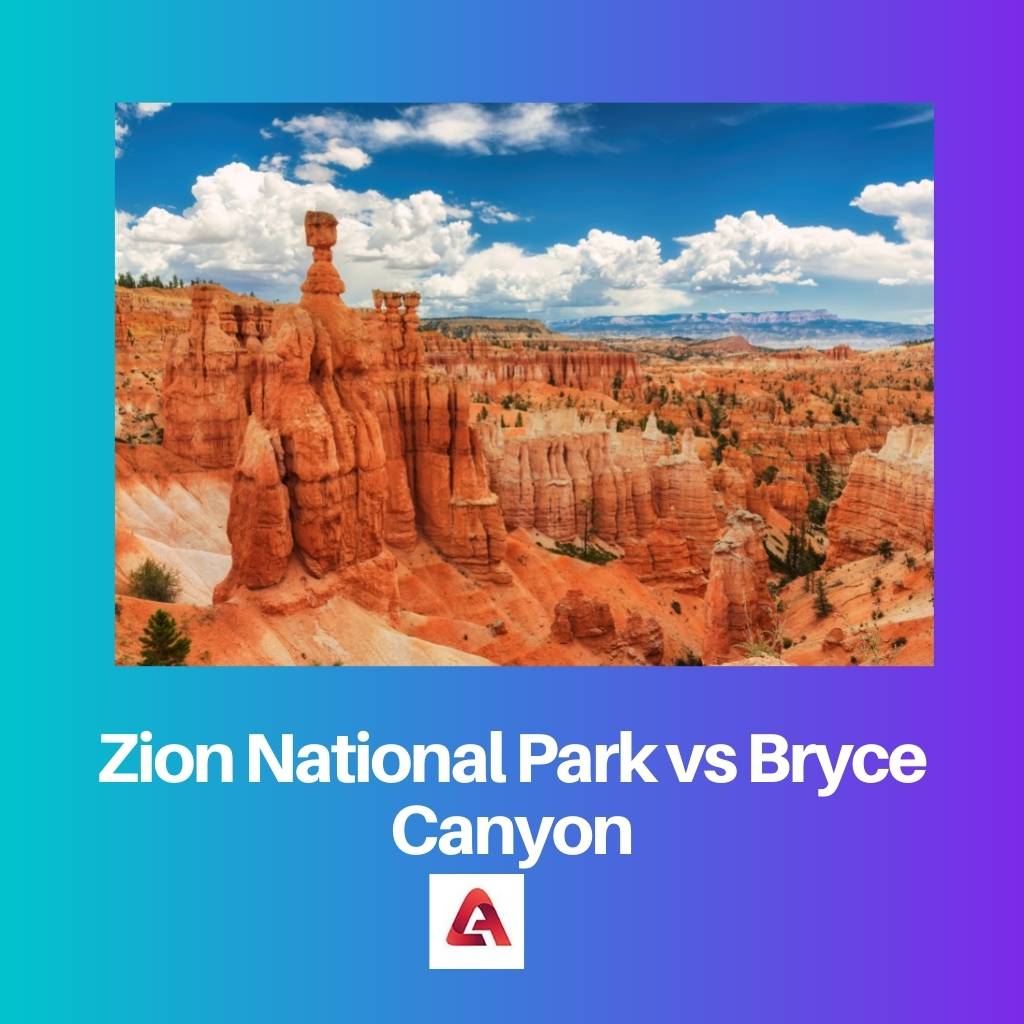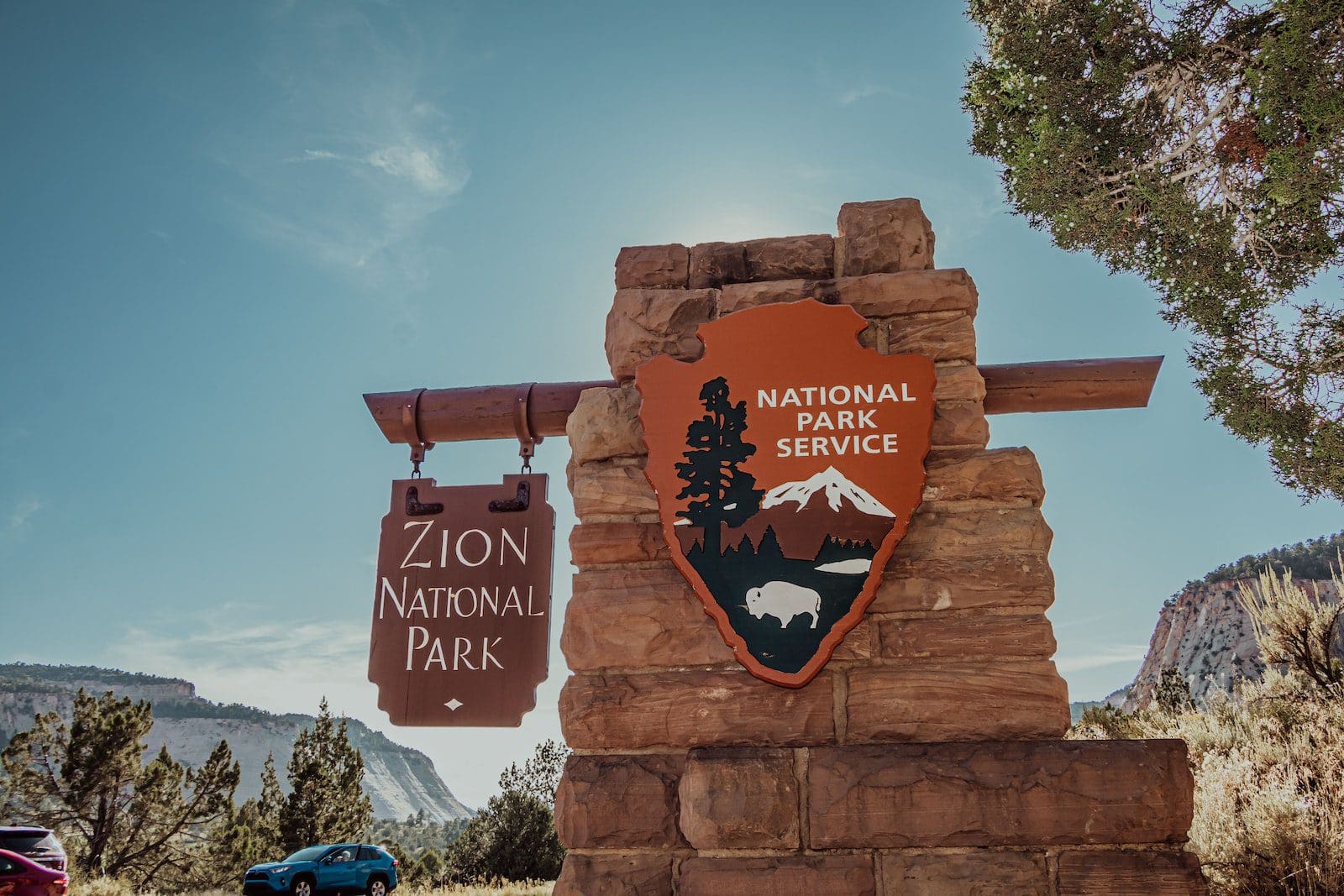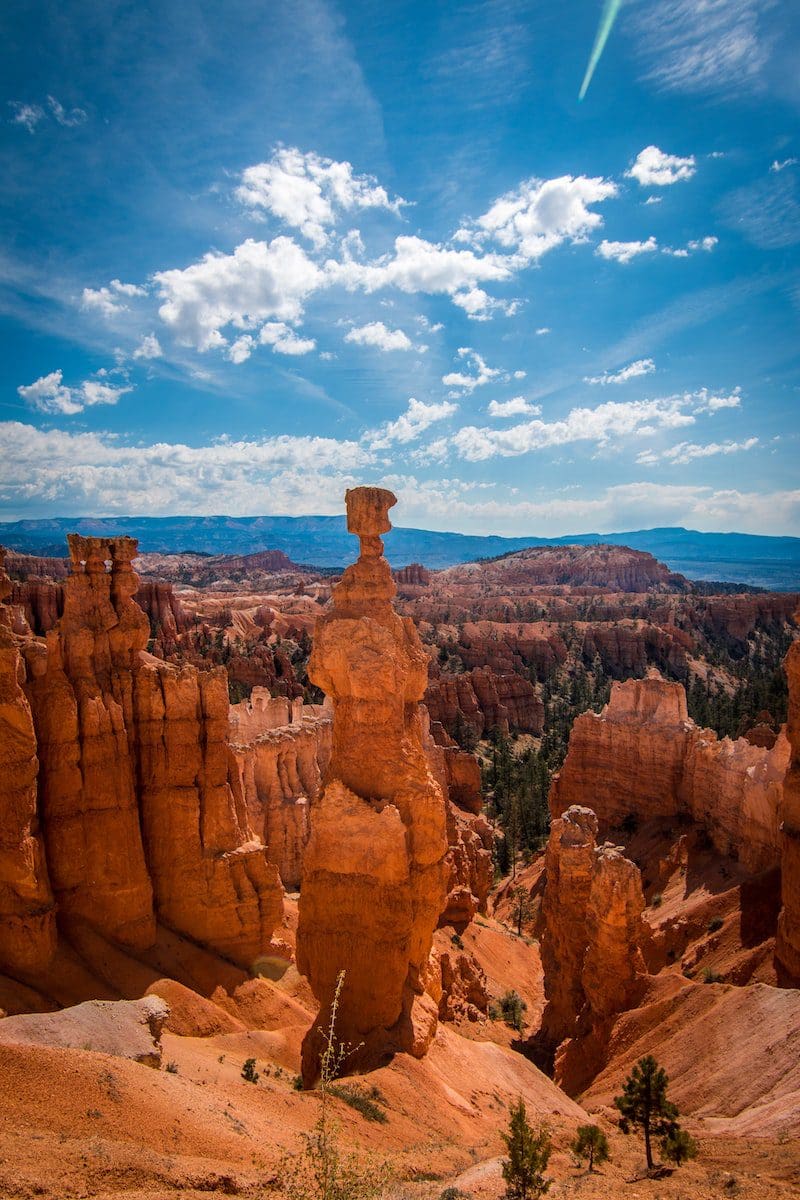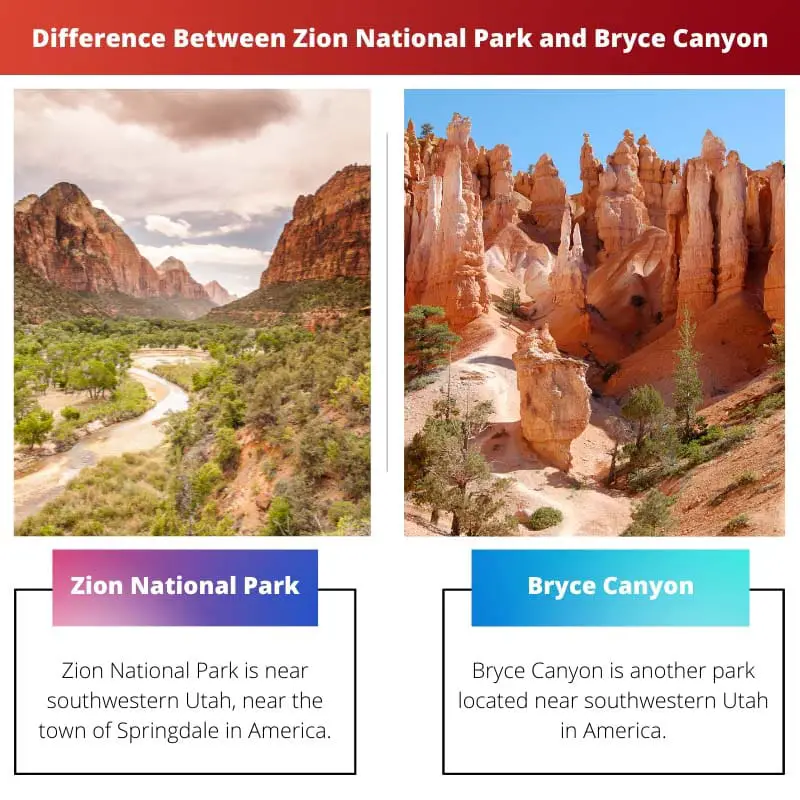Across the world, there are many places which are worth visiting. Every city, state, or country is unique in its religion, culture, food, environment, and many more other things. People travel to different places and explore them, which is known as tourism.
Even tourism is the bread butter for people living in some countries or states. Globally some places are rich in flora and fauna, while some places have many beaches, art, heritage, or the surreal beauty of mountains.
Key Takeaways
- Zion National Park is known for its towering red cliffs and narrow slot canyons, while Bryce Canyon is famous for its unique rock formations called hoodoos.
- Zion National Park has more hiking trails and opportunities for rock climbing, while Bryce Canyon has more scenic overlooks and viewpoints.
- Zion National Park has a warmer climate than Bryce Canyon, which can experience heavy snowfall during the winter months.
Zion National Park vs Bryce Canyon
Zion National Park is known for its towering sandstone cliffs and canyons and has a wider range of hikes, including trails through narrow slot canyons. Bryce Canyon is famous for its unique hoodoos, tall, thin spires of rock and is known for its dark sky stargazing opportunities.

Zion National Park is a park in America located in southwestern Utah near the town of Springdale. The additional feature of the national park is Zion Canyon which is 590 sq. km.
The Zion Canyon walls got their reddish and tan color because of the erosion by the North Folk of Virgin River. The park is rich in flora and fauna, and many varieties are easy to find.
Bryce Canyon is another park which is located in America near southwestern Utah. Like its name, the place doesn’t originally have a canyon but the natural amphitheatre present on the eastern side of the Paunsaugunt Plateau.
The Bryce Canyon was founded by a Mormon pioneer in the late 1850s, and the Canyon was named after Ebenezer Bryce. Even in the year 1923, President Warren G. Harding designated the Bryce Canyon as a national monument.
Comparison Table
| Parameters of Comparison | Zion National Park | Bryce Canyon |
|---|---|---|
| Height or Elevation | 4000 feet – 6500 feet | 9000 feet – 7000 feet towards downward |
| Climate | Likewise Desert | High-desert climate |
| Temperature | Maximum – 100° Minimum – 50° | Maximum – 80° Minimum – 40° |
| Vegetation | Cottonwood trees, Pinyon Pines, Juniper, Cactus, Desert Willow | Ponderosa Pine trees, Sagebrush, Manzanita bushes, Quaking Aspens, and Blue Spruce Pines |
| Area | 229 square miles | 90 square miles |
| Fauna | 291 bird species and 78 species of mammals | 175 bird species and 59 species of mammals |
| Popularity | 4th most visited park in America | 12th most visited park in America |
What is Zion National Park?
Zion National Park is near southwestern Utah, near the town of Springdale in America. The park is widely spread across 229 square miles. The park’s main feature of the place of attraction is Zion Canyon, which is made up of Navajo sandstone because of the erosion by the North Folk of Virgin River.
The Zion National Park is elevated at a height of 4000 feet to 6500 feet. The average temperature of the Park rises to a level of 100° around July and falls to around 50° in the lower elevation. Because of the high-temperature range, the climate of the place is like a desert and a bit warmer.
In the park, numerous plants or trees can be found, like cottonwood trees, pinyon pines, juniper, cactus, and desert willow, 291 species of birds (of which 12 species are bats), and 78 species of mammals can be found.
The park supports four life zones – desert, woodland, riparian, and coniferous forest. Also, it includes many mountains, rivers, naturally formed arches, canyons, monoliths, and many more things.

What is Bryce Canyon?
Bryce Canyon is another park located near southwestern Utah in America. The place and name Bryce Canyon are opposite in reality because originally, there was no canyon there but a natural amphitheatre present there along the eastern side of the Paunsaugunt Plateau.
The place was founded by the Mormon pioneer in the late 1850s, and the name came after Ebenezer Bryce. In the year 1923, President Warren G. Harding allocated the place as a national monument.
The elevation of the Canyon is around 9000 feet to 7000 feet downwards. The average temperature of the place rises to 80° and falls around 40°. The area is widely spread to around 90 square miles.
The vegetation of the place is Ponderosa Pine trees, Sagebrush, Manzanita bushes, Quaking Aspens, and Blue Spruce Pines. Also, 175 bird species and 59 species of mammals can be found.

Main Differences Between Zion National Park and Bryce Canyon
- Zion National Park is located at a height of about 4000 feet to 6500 feet, while Bryce Canyon is located at a height of about 9000 feet to 7000 feet but towards downwards.
- The climate of Zion National Park is likewise desert and is warmer compared to that of the climate of Bryce Canyon, which is less warm and high-desert conditions.
- The maximum temperature of Zion National Park reaches up to 100°, and the minimum temperature falls to 50° while contrastingly, the maximum temperature of Bryce Canyon reaches up to 80° and falls up to 40°.
- Zion National Park is highly rich in desert vegetation such as Cottonwood trees, Pinyon Pines, Juniper, Cactus, and Desert Willow, while on the other hand, Bryce Canyon is also rich in vegetation like Ponderosa Pine trees, Sagebrush, Manzanita bushes, Quaking Aspens, and Blue Spruce Pines.
- Zion National Park is spread across an area of 229 square miles, while on other hand, Bryce Canyon is spread across an area of 90 square miles.
- The tourists may find many species across the Zion National Park of about 291 bird species and 78 species of mammals (mule deer, foxes, bighorns, sheep) while on the other hand, in Bryce Canyon, individuals may find about 175 bird species and 59 species of mammals (mule deer, prairie dog).
- Zion National Park is among the top 4th most popular national parks in America, while on the contrary, Bryce Canyon is in 12th position in popularity in America.

References
- https://www.tandfonline.com/doi/abs/10.1080/14616688.2018.1437767
- https://www.sciencedirect.com/science/article/abs/pii/S0169204600000554
- https://web.b.ebscohost.com/abstract?direct=true&profile=ehost&scope=site&authtype=crawler&jrnl=19428162&AN=134381726&h=z%2f8Ujc%2ftVdvtVC6MnW6oRHUgyvq4bv0MgIlQ8tPeO7CyDH1Os36%2fV6CcfRr19%2bmgezGsnjt0%2fznFKVwwA9Ew%2bA%3d%3d&crl=c&resultNs=AdminWebAuth&resultLocal=ErrCrlNotAuth&crlhashurl=login.aspx%3fdirect%3dtrue%26profile%3dehost%26scope%3dsite%26authtype%3dcrawler%26jrnl%3d19428162%26AN%3d134381726
- https://www.sciencedirect.com/science/article/abs/pii/S2211973613000056

The information provided in this article about the elevation, climate, and popularity of both Zion National Park and Bryce Canyon is truly enlightening. This data-driven comparison is incredibly helpful for prospective visitors.
Well articulated, Aiden90. This article certainly aids in making an informed decision for those planning a visit to these national parks.
I couldn’t agree more, Aiden90. The detailed examination of these parks’ features is extremely valuable for travelers.
I appreciate the detailed insights into both Zion National Park and Bryce Canyon. Learning about the variety of plant and animal life in these regions has given me a newfound appreciation for their ecological diversity.
Absolutely, Lola84. The ecological diversity highlighted in this article emphasizes the importance of preserving these natural habitats.
I share your sentiment, Lola84. The ecological richness of these national parks is truly awe-inspiring.
This article offers a wonderful overview of Zion National Park and Bryce Canyon. The detailed comparison table provides a comprehensive view of the differences in elevation, climate, and plant and animal life in these two stunning locations.
I completely agree, Matthews Matthew. The comparison table is particularly helpful in understanding the distinctions between Zion National Park and Bryce Canyon.
Absolutely, Matthews Matthew. The in-depth analysis of the parks’ features and popularity makes it easier to grasp the unique selling points of each destination.
This comprehensive comparison of Zion National Park and Bryce Canyon offers a thorough understanding of the unique characteristics and attractions of each location. The attention to detail in describing the geography and wildlife of these parks is commendable.
I concur, Acox. The detailed exploration of the features of both parks enhances our appreciation for the natural wonders they hold.
This is an excellent piece that delves into the historical and geographical facets of Zion National Park and Bryce Canyon. The information about the founding of Bryce Canyon by a Mormon pioneer adds an interesting cultural perspective to the discussion.
Well said, Ashley Robinson. Understanding the historical background adds depth to the appreciation of these natural wonders.
The detailed information about the elevation, climate, vegetation, and wildlife of Zion National Park and Bryce Canyon is both fascinating and informative. The article presents a wealth of knowledge that is essential for anyone planning a visit to these sites.
Absolutely, Jack Ward. The comprehensive insights provided in this article are extremely valuable for anyone considering a trip to these breathtaking national parks.
I completely agree, Jack Ward. This article serves as an excellent resource for travelers interested in the natural beauty of Zion National Park and Bryce Canyon.
I value the in-depth comparisons of Zion National Park and Bryce Canyon outlined in this article. The information about the popularity and distinguishing features of both locations is truly enlightening.
Well said, Murphy Stephen. This article expertly highlights the intriguing differences between these two remarkable national parks.
I share your sentiment, Murphy Stephen. The article provides an excellent overview of the distinct attractions and characteristics of each park.
It’s fascinating to learn about the unique geographical features and climate of both Zion National Park and Bryce Canyon. The rich description of the flora and fauna in these regions is truly captivating.
I couldn’t agree more, James Eden. The distinct characteristics of each park make them appealing to different types of nature enthusiasts.
Thank you for providing such a comprehensive comparison of Zion National Park and Bryce Canyon. The descriptions of the distinct vegetation and geographic features are enlightening.
I couldn’t agree more, Mason Gary. This article has truly broadened my understanding of these two magnificent parks.
Thank you for this informative comparison of Zion National Park and Bryce Canyon. I appreciate the detailed breakdown of the differences between these two beautiful natural landmarks.
I agree, Mark44. This article presents a wealth of information about both destinations, making it easier to decide which one to visit for a future trip.